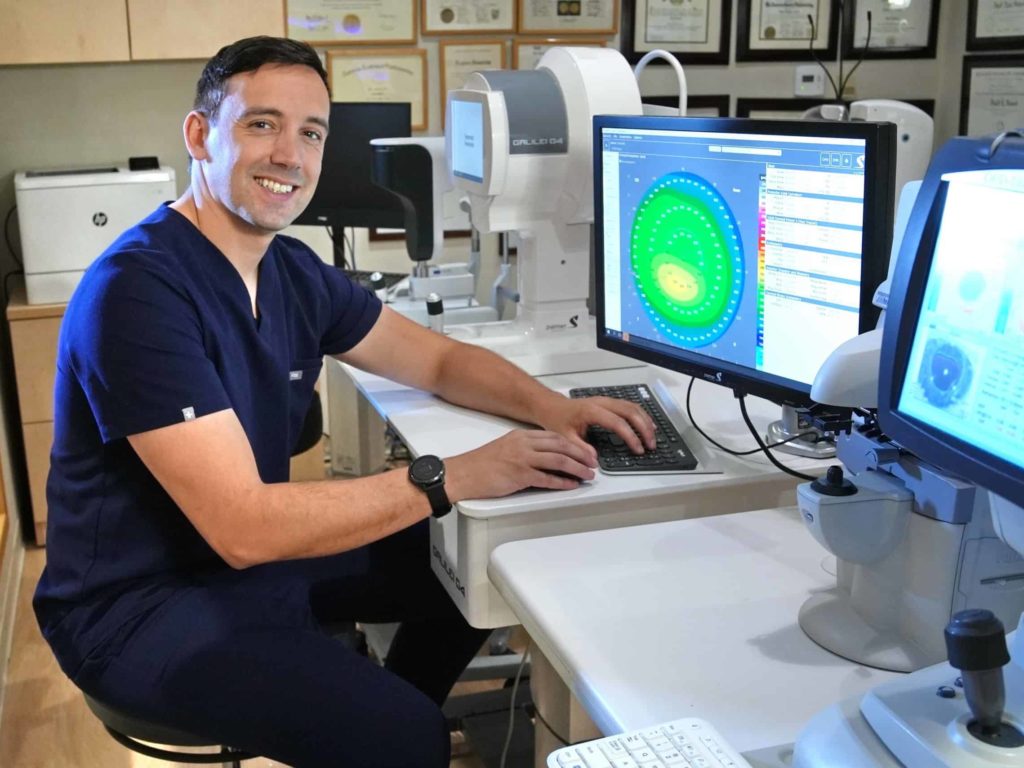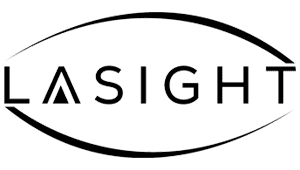LASIK Consultation | What to Expect
LA Sight’s Comprehensive Laser Vision Correction Consultation
 When you come to LA Sight for your laser vision correction evaluation, we perform a variety of special tests designed to evaluate your candidacy. Many prospective clients are impressed by the ease, elegance and sophistication of the process. We firmly believe that careful, meticulous evaluations contribute to great results. For those who have not had prior vision correction surgery, we provide our laser correction consultations (LASIK, PRK) on a complimentary basis. Fees do apply for lens-based surgical care evaluations and for those who have had prior vision correction care elsewhere. Schedule Your Consultation
When you come to LA Sight for your laser vision correction evaluation, we perform a variety of special tests designed to evaluate your candidacy. Many prospective clients are impressed by the ease, elegance and sophistication of the process. We firmly believe that careful, meticulous evaluations contribute to great results. For those who have not had prior vision correction surgery, we provide our laser correction consultations (LASIK, PRK) on a complimentary basis. Fees do apply for lens-based surgical care evaluations and for those who have had prior vision correction care elsewhere. Schedule Your Consultation
LASIK should not be undertaken lightly; this is not trivial surgery even though it is rather quick, and painless. We recommend careful selection of a LASIK provider and offer advice through our 50 Tough Questions to Ask Your Surgeon and Finding a Good LASIK Surgeon pages.
The preliminary testing typically takes about 20 to 30 minutes. When this is complete, you will meet Dr. Moarefi to review the results, discuss your options, and have all your questions addressed.
The following are the steps taken and tests performed as a part of our initial laser vision correction evaluation:
- General health and eye health assessment. We start by asking you to complete a brief questionnaire regarding your vision, your interests, visual needs, eye health and medical history. This can be done on arrival at the office or, if you’d prefer, with our Secure Online Registration Form hosted on our secure server.
- Auto-Refraction and Wavefront Analysis: A very sophisticated method of measuring the optical prescription and other characteristics of each eye as a unique visual system. ‘Wavefront’ is another term for ‘aberrometry,’ the measurement of each eye’s individual optical aberration profile. To learn more about this interesting new technology and capability, see Wavefront Imaging Explained.
- Orbscan Corneal Topography and Thickness Mapping: The Orbscan is a very sophisticated instrument, designed to measure and map corneal topography for both front and back corneal surfaces, and to map corneal thickness across the entire corneal surface. As a diagnostic tool this shows the overall architecture of the cornea including surface power, front curvature, back curvature, and thickness variation. Only about 3% of all laser vision correction centers in the US have access to this technology due to its cost.
- Prescription Analysis: Measurement of the prescription in your current glasses.
- Visual Acuity: Measurement of your unaided (glasses off) and corrected (glasses on) vision.
- Pupillometry: Measurement of pupil size in darkness, using a special night-vision scope.
- Subjective Refraction: Measurement of your best current prescription.
- Pachymetry: Measurement of corneal thickness using ultrasound (“sonar”) instrumentation. The Orbscan, while very helpful in providing thickness mapping across the entire corneal surface, is sometimes not as accurate as ultrasonic measurement. In an effort to measure as accurately and completely as possible, we employ both methods. Based upon the above information, our staff and our surgeons will be able to advise you about your candidacy for LASIK and/or other methods of vision correction. For those that choose to proceed with surgical corrective care, we perform more extensive testing as follows:
- Wavefront Analysis: Measurement of optical characteristics of the eye which includes assessment of certain subtle features called aberrations is commonly referred to now as wavefront analysis. This is done by computer-based optical sensors and is a more sophisticated method of prescription measurement than the traditional “Which is better, one or two?” method called a subjective refraction (which dials in a correction using combinations of simple lenses). At LA Sight, we perform wavefront analysis as a part of every consultation. For a more detailed description of wavefront imaging, technology and capability, see Wavefront Imaging Explained.
- Slit-Lamp Microscopy: Examination of the eyes and eyelids using a special microscope.
- Dilated Exam and Cycloplegic Refraction: To evaluate retinal health, and to double-check/confirm accuracy of the undilated prescription measurement after relaxing the internal focusing muscles of the eyes.
What These Tests Measure, and Why They’re Important:
General Health Review:
It is known that certain medical conditions can result in abnormalities of collagen, or abnormal healing of collagen. Since LASIK involves sculpting the collagen layer of the cornea, we need to know in advance if any of these potential problems exist. Individuals with rheumatoid arthritis, or systemic lupus, are generally advised that they are not ideal candidates, due to abnormal collagen. The hormonal changes that accompany pregnancy may cause a change in bones, joints, soft tissue, and the prescription of the eyes, so that may not be an optimum time to consider vision correction. Use of certain medications (specifically Acutane and Cordarone) may also pose a problem.
Eye Health Assessment:
It should be self-evident that healthy eyes, eyelids, ocular surface and related structures are a prerequisite to any contemplated elective eye surgery.
 |
Automated Refraction, Topography and Wavefront Analysis: Using infrared sensors and auto-focus technology, autorefractors are able to measure the optical state of the eye, (nearsightedness, farsightedness, astigmatism) called the refraction. While very accurate, the readings are not always perfect, so the process of ‘subjective refraction’ (having the examiner ask “Which is better, one or two?”) is still performed to fine-tune the measurements. In the near future, wavefront analysis may replace even this time-honored method of measuring the prescriptive needs for optimum vision.
At LA Sight we use the Marco 3D-Wave system for initial testing. This instrument combines capability of autorefraction, corneal topography measurement and wavefront analysis. |
 |
Galilei dual-surface corneal topography mapping: The cornea accounts for about 65% of the eyes’ focusing power. In the normal case, corneal curvature is smooth, symmetric, and regular in contour. However, certain conditions are associated with irregularity, distortion, or significant asymmetry of corneal curvature. Examples include keratoconus, a disorder characterized by abnormal thinning of the cornea, with distortion and irregular, abnormally steep curvature over the area of thinning. Current laser systems are not able to correct these conditions, so topography helps identify those who would not be good candidates for laser sculpting surgery. Galilei analysis may also help guide recommendations about which procedure would be the most appropriate for you (sometimes we advise PRK instead of LASIK). In certain cases of topographic asymmetry, laser vision correction is contraindicated.
The Galilei is a sophisticated instrument, designed to measure corneal topography of both front and back corneal surfaces, and to map corneal thickness across the entire corneal surface. A relatively small percentage of laser vision correction centers in the world have access to this technology. |
 |
Prescription Analysis: Modern instruments called lens analyzers can measure the existing prescription in your current eyeglasses. It is helpful to know this information, even if your glasses are several years old. By comparing the prescription in the existing glasses to the current one measured at the time of consultation, we know if there has been any change in the prescription over time; and we also know by how much the prescription has changed. |
 |
Pupillometry: Measurement of pupil size in darkness (by a modified night-vision scope) is important for several reasons. First, it is preferable if the intended diameter of the laser sculpting treatment (called the “optical zone”) is at least as large as the pupil diameter. If not, then some light entering the eye will come from outside the optical zone, and contribute to glare, halo, blur, and image degradation. Second, when correcting nearsightedness, the depth of the treatment is proportional to the diameter of the optical zone. In order to calculate how deep the treatment will extend, we must also know how wide a diameter needs to be treated. We use both the (digital, automated) Neuroptics pupillometer and a more conventional analog instrument called the Colvard pupillometer. |
 |
Subjective Refraction: The process of measuring and fine-tuning the prescription measurement. Typically a person sits behind an instrument containing many types of lenses (a phoropter) and the examiner carefully adjusts the combination of lenses to optimize vision clarity. This is a subjective, interactive process where feedback is essential (but often boring), which is why the examiner will ask, “Which is better, one or two?” |
 |
Slit-Lamp Microscopy: The eyelids and eyes are examined in high magnification using a special microscope with a slit-shaped beam. This affords a close-up view of the eyelids, conjunctiva (inside lining of the lids and membrane covering the sclera), cornea, sclera, iris, anterior chamber, pupil, lens, and anterior vitreous. Eye pressure can also be measured with a tonometer attached to the slit-lamp microscope. |
 |
Pachymetry: Corneal thickness is important to measure, as laser treatment involves delicately sculpting – and therefore slightly thinning – the cornea. It is generally accepted that the cornea can retain its’ structural integrity as long as such sculpting does not reduce thickness below a safe level. |
We typically perform the above testing and evaluation on a complimentary basis for individuals interested in laser vision correction. Fees may be applicable for evaluation of cataract and IOL care, for the consultation and for certain special testing. If any Extended Testing is warranted or advised, you will be informed that fees may be incurred.
We do charge for consultative evaluation of patients that have received LASIK or other vision corrective surgery elsewhere, prior to seeking care through our office. If you desire to retain copies of any information from the free consultation, a fee will be incurred. It is our policy that information obtained as a part of the free evaluation is for internal use only.
